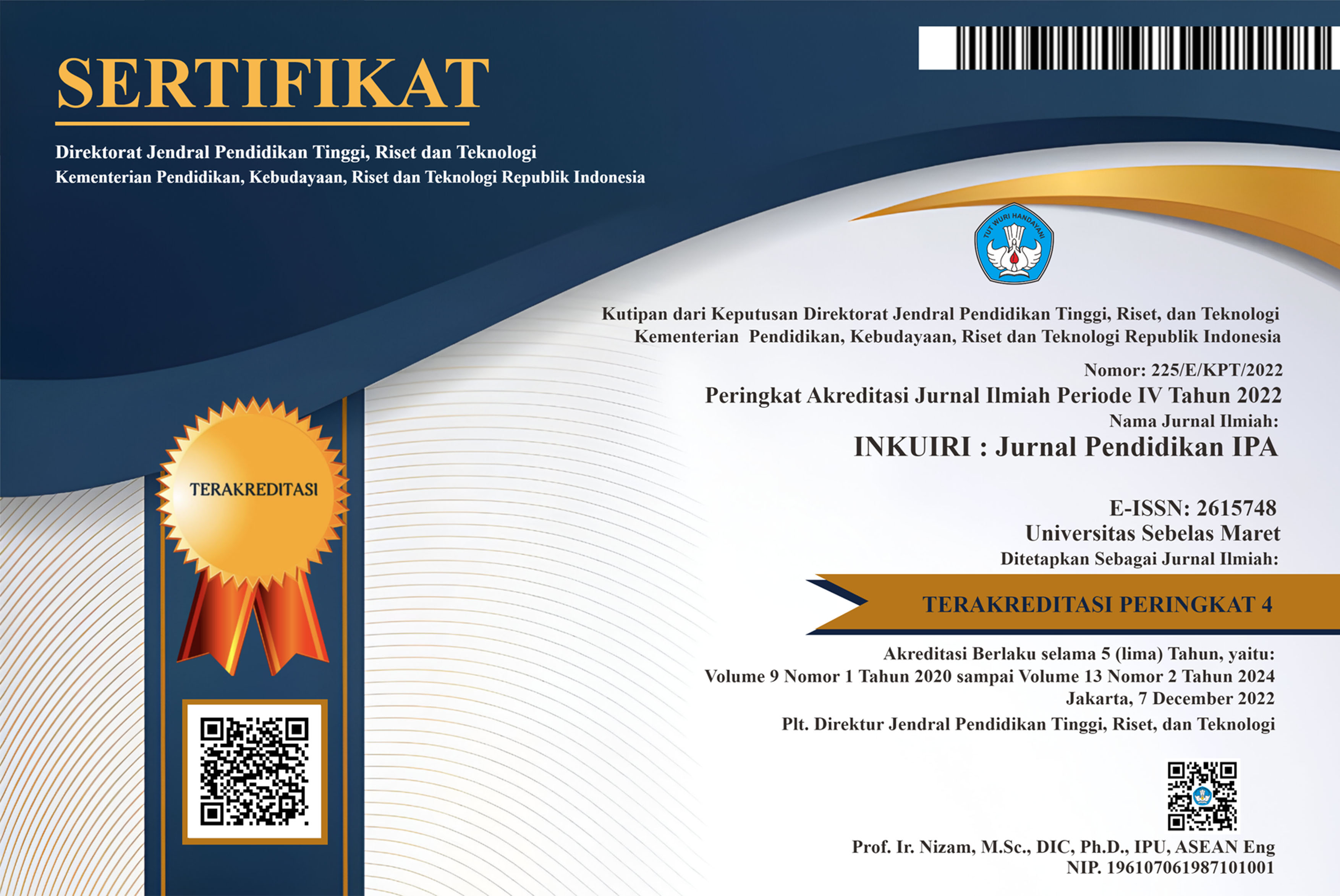ANALISIS KEMAMPUAN ARGUMENTASI SISWA SMP PADA MATERI PENCEMARAN LINGKUNGAN
Abstract
Penelitian ini bertujuan untuk mengetahui kemampuan argumentasi siswa SMP terkait materi pencemaran lingkungan. Penelitian ini menggunakan metode penelitian deskriptif dengan pendekatan kuantitatif. Penelitian dilaksanakan di salah satu SMP yang berlokasi di Lembang, Kabupaten Bandung Barat pada 29 orang siswa kelas VII sebagai sampel yang telah dipilih menggunakan teknik random sampling. Instrumen penelitian yaitu tes berbentuk uraian (essay) sebanyak 6 butir soal yang disusun berdasarkan indikator kemampuan argumentasi (claim, data, warrant, backing). Instrumen yang digunakan divalidasi oleh tiga validator yaitu dua dosen ahli dan satu guru bidang studi IPA. Jawaban siswa dianalisis berdasarkan komponen argumentasi yang terkandung didalamnya. Hasil penelitian menunjukkan bahwa 93,10% siswa menuliskan claim, 54,02% siswa menuliskan data, 48,85% siswa menuliskan warrant, dan 45,40% siswa dapat menuliskan backing. Secara keseluruhan dapat disimpulkan bahwa sebagian besar siswa mampu menuliskan claim namun mulai mengalami kesulitan untuk mengemukakan data, warrant, dan backing. Persentase kemampuan awal siswa dalam berargumentasi tersebut dapat dijadikan sebagai acuan bagi guru sehingga kedepannya dapat menentukan desain atau kegiatan pembelajaran yang tidak hanya berfokus pada pemahaman konsep tetapi juga dapat membangun atau melatih kemampuan argumentasi siswa.
This study aims to determine the argumentation ability of junior high school students related to environmental pollution. This study uses a descriptive research method with a quantitative approach. The research was carried out in one of the junior high schools located in Lembang, West Bandung Regency on 29 seventh grade students as a sample that had been selected using random sampling technique. The research instrument is a test in the form of a description (essay) of 6 questions which are arranged based on indicators of argumentation ability (claim, data, warrant, backing). The instrument used was validated by three validators, namely two expert lecturers and one science teacher. Students' answers were analyzed based on the argumentative components contained therein. The results showed that 93.10% of students wrote claims, 54.02% of students wrote down data, 48.85% of students wrote warrants, and 45.40% of students could write backings. Overall, it can be concluded that most of the students are able to write claims but are starting to have difficulty presenting data, warrants, and backings. The percentage of students' initial ability to argue can be used as a reference for teachers so that in the future they can determine designs or learning activities that not only focus on understanding concepts but can also build or train students' argumentation skills
Keywords
Full Text:
PDFReferences
Chen, H. T., Wang, H. H., Lu, Y. Y., Lin, H. S., & Hong, Z. R. (2016). Using a modified argument-driven inquiry to promote elementary school students’ engagement in learning science and argumentation. International Journal of Science Education, 38(2), 170–191. https://doi.org/10.1080/09500693.2015.1134849
Devi, N. D. C., Susanti VH, E., & Indriyanti, N. Y. (2019). Analysis of High School Students’ Argumentation Ability in the topic of Buffer Solution. JKPK (Jurnal Kimia Dan Pendidikan Kimia), 3(3), 141. https://doi.org/10.20961/jkpk.v3i3.23308
Dewina, S., Suganda, O., & Widiantie, R. (2017). Pengaruh Model Pembelajaran Problem Based Learning (PBL) Terhadap Kemampuan Menganalisis dan Keterampilan Berargumentasi Siswa Pada Konsep Pencemaran Lingkungan di Kelas X. Quagga: Jurnal Pendidikan Dan Biologi, 9(2), 54–65.
Erduran, S., & Kaya, E. (2016). Scientific Argumentation and Deliberative Democracy: An Incompatible Mix in School Science? Theory into Practice, 55(4), 302–310. https://doi.org/10.1080/00405841.2016.1208067
Erduran, S., Kaya, E., & Cetin, P. S. (2012). Discourse, Argumentation, and Science Lessons : Match or Mismatch in High School Students’ Perceptions and Understanding? Mevlana International Journal of Education (MIJE), 2(3), 1–32.
Erduran, S., & Msimanga, A. (2014). Science curriculum reform in South Africa: Lessons for professional development from research on argumentation in science education. Education as Change, 18(SUPPL.1), 37–41. https://doi.org/10.1080/16823206.2014.882266
Erduran, S., Simon, S., & Osborne, J. (2004). TAPping into argumentation: Developments in the application of Toulmin’s Argument Pattern for studying science discourse. Science Education, 88(6), 915–933. https://doi.org/10.1002/sce.20012
Gray, R., & Kang, N. H. (2014). The Structure of Scientific Arguments by Secondary Science Teachers: Comparison of experimental and historical science topics. International Journal of Science Education, 36(1), 46–65. https://doi.org/10.1080/09500693.2012.715779
Handayani, P., Murniati, & Sardianto, M. S. (2015). Analisis Argumentasi Siswa Kelas X SMA Muhammadiyah 1 Palembang Dengan Menggunakan Model Argumentasi Toulmin. Jurnal Inovasi Dan Pembelajaran Fisika, 2(1), 60–68.
Larrain, A., Freire, P., & Howe, C. (2014). Science Teaching and Argumentation: One-sided versus dialectical argumentation in Chilean middle-school science lessons. International Journal of Science Education, 36(6), 1017–1036. https://doi.org/10.1080/09500693.2013.832005
OECD. (2016). PISA 2015 Assessment and Analytical Framework: Science, Reading, Mathematic and Financial Literacy,. OECD Publishing. https://doi.org/10.1787/9789264255425-en
Venville, G. J., & Dawson, V. M. (2010). The impact of a classroom intervention on grade 10 students’ argumentation skills, informal reasoning, and conceptual understanding of science. Journal of Research in Science Teaching, 47(8), n/a-n/a. https://doi.org/10.1002/tea.20358
Yunisa, W., Jalmo, T., & Maulina, D. (2015). Pengaruh Penggunaan Model Problem Solving terhadap Kemampuan Berargumentasi dan Hasil Belajar Siswa, 3(5). Retrieved from http://garuda.ristekdikti.go.id/journal/article/328066
Refbacks
- There are currently no refbacks.






